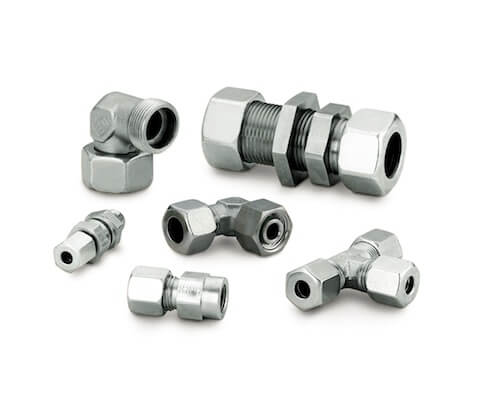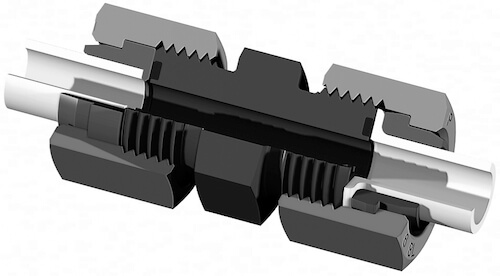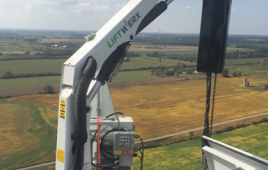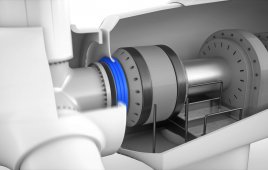 Anthony Palanci
Anthony Palanci
Product Sales Manager
Tube Fittings Division
Parker Hannifin Corporation
Cleveland, Ohio
parker.com/TFD
The cost of scheduled maintenance for wind turbines has been relatively low. However, unscheduled maintenance is a completely different story. Until recently the turbine manufacturer’s warranty has covered unscheduled maintenance and repair costs. But that’s changing as a large number of turbines come off warranty and U.S. installations increase. These trends have triggered demand for turbines with longer-lasting components and warranty periods that extend to seven years—rather than the two to five years most currently offer.
Component Failures
Vibration contributes to hydraulic component failures in wind turbines. Other causes of failure include environmental factors, such as extreme heat and cold, and corrosion in offshore installations. Hydraulic fittings used in a turbine’s many high-pressure hydraulic applications have the ability to overcome these failure modes, though they are often overlooked in the design phase. Typical high-pressure connections are located in pitch, yaw, and braking systems. Fittings are also used in gearbox lubrication systems to transfer fluids for filtration.

Soft-Seal fittings come in a wide variety of types and styles. When used in the ‘ hydraulic of a wind turbine, the fittings let manufacturers extend warranty periods.
Causes of leakage in hydraulic systems
The greatest nemesis in wind-turbine design and application is commonly considered to be fluid leakage in hydraulic connections. But what causes leakage is surprising. Four leading contributors and how often they are a factor, include:
- Improper installation, 60%
- Poor system design, 20%
- Quality of components, 15%
- System abuse, 5%
While causes of leakage are identifiable, results can vary significantly. A sure consequence is that any leakage will cost money. Based on a 24-hours-a-day operation with lubrication oil at $10 per gallon, here’s how a single leak can add up to a sizable expenditure if not corrected:
- 1 drop every 1 minute = 6.7 gallons per year = $67
- 1 drop every 10 seconds = 40 gallons per year = $400
- 1 drop every 5 seconds = 80 gallons per year = $800
- 1 drop every second = 402 gallons per year = $4,020
In addition to fluid loss, many costs associated with leaks are often overlooked. Some of the less visible ones are:
- Energy loss
- Safety hazards
- Maintenance costs
- Warranty issues
- Environmental responsibilities
Design considerations
System design is the first line of defense in leak prevention. It involves selecting the right components for wind turbines to reduce the occurrences of leaks and hydraulic connection failures. For those in the design phase of a turbine hydraulic system, consider these characteristics when selecting hydraulic components:
Application – the wind turbine’s environment will influence fitting design and selection. Protective coatings are usually applied to steel fittings to extend their useful life in corrosive environments. The most common finish for steel fittings is electroplated zinc. It will corrode sacrificially, protecting the steel base metal from normal rusting due to the presence of oxygen, moisture, and acidic gases. Stainless steel is used for highly corrosive environments typically seen in offshore wind installations.
Pressure – What is the minimum and maximum operating pressure seen in the hydraulic system, including potential spikes?
The rated dynamic pressure of the fitting should be equal to or higher than the system pressure. As a general rule, tube fittings are rated at a 4:1 design factor. The design factor is generally applied as a ratio of the materials’ ultimate strength with respect to the dynamic pressure rating of the connection. The 4:1 design factor applies to “normal” operating conditions, with moderate mechanical and hydraulic shocks. For severe wind turbine vibration and shock operating conditions, a “de-rating factor” should be applied directly to the dynamic pressure of the fitting as shown in the table Severity of Service.

Shock – Will the component be subjected to mechanical or hydraulic shocks that could be detrimental to its expected life?
Vibration – How severe is the vibration? Will it cause the components to loosen or fail prematurely?
Temperature (ambient and fluid) – What extremes will the system be subjected to? How will they affect component materials?
The operating temperature range for tube fittings depends on the material, plating, and seal. Temperature ranges for both the fitting and seal material are given in the table Material temperatures for fittings and seals.

Environment – Where will the system be operating? How will the location affect its performance? Will there be excessive corrosive or mechanical abuse?
Contamination – Are contaminants introduced to the system through the style or quality of the fitting selection?
Fluid velocities – Does the tube and fitting size allow for acceptable velocity?
Size – the tube O.D. and wall thickness must be considered for all tube fittings. With most tube ends, there are limitations with respect to the tube and wall thickness. Other selection factors include system pressure, flow, temperature, and the service environment.
Media – the type of fluid being conveyed is important, and must be considered when selecting the fitting material and seal.
Soft O-ring leak-free fittings prevent vibration failure
Many recent industrial and wind turbine systems use metal-to-metal sealing methods in their hydraulic connections. The standard metal-to-metal fitting used in wind turbines is the metric 24° flareless, DIN 2353 style. Using soft-seal fittings versus traditional metal-sealing fittings lets manufacturers extend warranty periods in turbine hydraulic systems by reducing the possibility of improper installation and fatigue failures. Additionally, soft-sealing hydraulic fittings have high-pressure capabilities, up to 11,000 psi (758.4 bars) as a standard working pressure.

Metric 24° bite-type DIN 2353 is the standard metal-to-metal fittings used in wind turbines. However, using soft-seal fittings instead helps reduce the chance of improper installation and fatigue failures.
The two soft-sealing hydraulic fittings applicable to the wind industry are metric 24° flareless O-ring (DIN 2353) and the inch sized O-ring face seal (SAE J1453). These fittings use an elastomeric seal that makes contact to seal the threads during fitting installation.
The soft O-ring face seals can eliminate leaks in high-pressure hydraulic systems—despite severe mechanical shocks and vibration. The fitting has a body, tube nut, sleeve, and O-ring. The O-ring soft seal sits in a groove in the fittings flat face. The sleeve permanently attaches to the tube either mechanically (by flanging) or by brazing.
As the nut tightens to the fitting body, the O-ring compresses between the body and flat face of the tube flange (or braze sleeve) to form a tight seal. The result is a more-reliable seal than possible with traditional metal-to-metal connections—though it comes with more restrictive media and temperature limitations. O-ring soft-face, seal-tube fittings can stop leakage in hydraulic connections up to a maximum of 11,000 psi (758.4 bars) under constant vibration and mechanical shock.
Compared with traditional bite technology, EO-2 O-ring soft-face seals (90 durometer) offer the following benefits versus bite fittings for wind turbine applications subject to constant vibration and mechanical shock:

An exploded view of an O-ring face seal fitting. Soft O-ring face seals help eliminate leaks in hydraulic systems, despite severe shocks and vibration.
- Soft elastomeric seal
- High degree of fine sealing – proven up to 11,000 psi (758.4 bars)
- Long-term reliability without re-tightening
- No air ingress
- Easy assembly check
- Unlimited repeated assembly
- Seal can be individually replaced
- Minimal possibility of over tightening the nut during assembly
- Long history of product effectiveness
The temperature range for soft-seal O-rings depends on the seal material. Nitrile is most common and typically has a range of –30 to 250°F (-34 to 121.1 °C). Fluorocarbon O-rings handle temperatures to 400°F (204.4°C), while other materials suit various fluids and temperatures.

O-ring fitting/tube assemblies offer a more reliable seal (left – braze end; right – flange end) than possible with traditional metal-to-metal connections.
Non-welded, leak-free pipe connections
For reliable leak-free wind turbine piping systems larger than 2-in. (50.8 mm), Parker’s Parflange F37 system (Figure 5) is a suitable alternative to time-consuming and costly welding. It lets engineers quickly make hydraulic pipe connections that are sufficiently robust for heavy-duty wind turbine applications.
The system uses two connection technologies for leak-free, weld-less connections: F37 flare and F37 retaining ring. The flare system provides a smooth, clean, high-strength flared tube end fitted with a seal carrier insert. For higher-pressure systems, a retaining ring holds the flange along with a highly engineered seal carrier for leak-free performance

Parker’s Parflange F37 technology lets engineers quickly make non-welded pipe connections robust enough for use in wind turbines.
Performance benefits include:
- Complete pre-engineered piping
- Reduced dependence on welded piping
- Fully heat code traceable
- Reduced system flushing time
- Pressure capabilities to 6,000 psi (420 bar)
- Reduced concerns of stress-corrosion cracking of welded joints
- Compliant with ISO 6162-1/-2, ISO 6164 (dimensions & flange patterns)
- DNS and ABS approved
To sum up
These high-pressure fitting systems (soft-seal O-ring and F37 non-welded flange assembly) are used in all fields of hydraulic applications. A wide range of designs and materials makes them particularly suitable for wind applications where safety, corrosion-resistant leak-free connections, and ease of assembly are important factors. The fittings can also play a significant role in designs that call for longer-lasting components and extended warranty periods.
Filed Under: Hydraulics, O&M





Dear sirs,
Good day.
Glad to hear you are in the market for rubber hoses.
Hyrotech is the professional manufacturer & exporter from China specializing in rubber hoses,industrial hoses, pvc hoses, hose accessories etc…
Our main items are as follows:
Hydraulic Hose(R1/1SN, R2 /2SN,R9, R12 etc… )
Industrial Hose( Fuel Oil Hose, LPG Hose ,Sand Blast Hose etc… )
Teflon Hose/SAE 100R14 (Smoothbore/ Convoluted)
Welding hose
Air/Water hose
Plastic Hose Guard
Our hoses have been exported to 40 countries such as America, Russia, Canada, Australia, Italy, France, UK and so on. The prices of our products are very competitive and our MOQ is very small.
For more details please refer to our website: http://www.hthydraulichoses.com or http://www.hyrotech.com
Any requirement or inquiry, pls. contact us.
Best regards,
Maggie Chen
Qingdao Hyrotech Rubber & Plastic Products Co., Ltd
Phone:86-532-88968560
Fax:86-532-88968560
Email: sales04@hyrotech.com
Web: http://www.hthydraulichoses.com